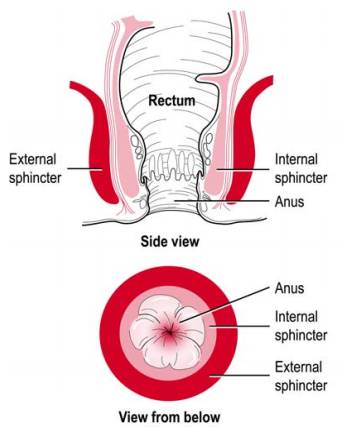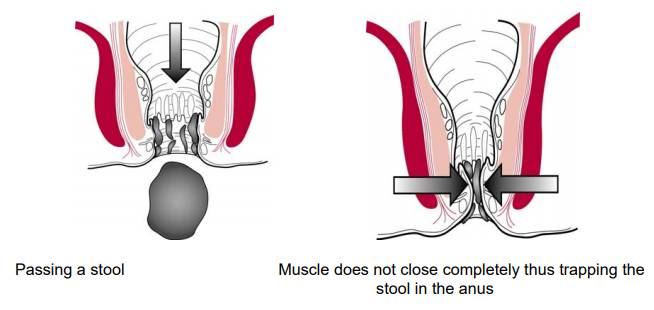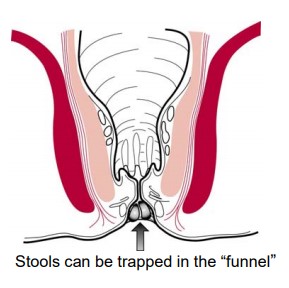Faecal Incontinence
Please note, this page is printable by selecting the normal print options on your computer.
Anal Sphincter Exercises for people with leakage from the bowel
Sphincter exercises can help you to improve leakage from the bowel. When done correctly, these exercises can build up and strengthen the muscles to help you to hold both gas and stool in the back passage.
Where are these muscles?
The back passage, or anus, has two rings of muscle around it (see diagram).

The inner ring is the internal sphincter, an involuntary muscle, which should be closed at all times, except when you are actually trying to open your bowels. This is normally automatic; you don’t have to think about doing it.
The outer ring of muscle is the external sphincter, which is a voluntary muscle which you can tighten up to close it more firmly if you have urgency or diarrhoea. Both muscles wrap right around the anus. Either or both of these sphincter muscles can become weak. This may be because of childbirth, constipation and straining or general wear and tear. Sometimes there is no obvious reason why. If you have weak muscles you may leak gas, liquid or solid stools.
When you pass a stool, there is usually some residue of the stool left behind in the anal canal (see diagram).
Normally, the sphincter muscles “snap shut” after you have finished opening your bowels to close off the back passage. This squeezes out any residue. You can then wipe clean and there is no further leakage.
If the muscles are damaged or weak, they may not close immediately or completely after you have been to the toilet. This often makes it difficult to wipe clean, and you may find that you leak for a while after opening your bowels. This may be a small or a large amount and may last only a few minutes, or several hours. You may also find that you leak during strenuous exercise, lifting heavy weights or when you walk any distance. Some people find that a small amount of a stool is passed with wind.

Other people with weak muscles have a “funnel-shaped anus”. The weak muscle does not close completely at skin level and stool is trapped inside the anal opening. This cannot be removed easily just by wiping (see diagram).

How can exercises help?
The internal sphincter, which is most often the problem underlying leakage, cannot be strengthened by exercises. It is an involuntary muscle that you cannot work just by willpower. It is the external sphincter muscle that you can exercise. The aim is to exercise this muscle enough to make it thicker and stronger so that it gives more support and may compress the internal muscle to prevent leakage.
Speeding the reaction of this muscle may also help with wind control. Like any other muscle in the body, the more you use and exercise them, the stronger the sphincter muscle will be. However, this will be hard work and often takes several months to be effective.
Learning to do the exercises
It is important to learn to do the exercises in the right way, and to check from time to time that you are still doing them correctly.
Sit comfortably with your knees slightly apart. Now imagine that you are trying to stop yourself passing wind from the bowel. To do this you must squeeze the muscle around the back passage. Try squeezing and lifting that muscle as tightly as you can, as if you are really worried that you are about to leak. You should be able to feel the muscle move. Your buttocks, tummy and legs should not move at all. You should be aware of the skin around the back passage tightening and being pulled up and away from your chair.
Really try to feel this. You are now exercising your anal sphincter. You should not need to hold your breath when you tighten the muscles!
Now imagine that the sphincter muscle is a lift. When you squeeze as tightly as you can your lift goes up to the 4th floor. But you cannot hold it there for very long, and it will not get you safely to the toilet as it will get tired very quickly. So now squeeze more gently, take your lift only up to the 2nd floor. Feel how much longer you can hold it than at the maximum squeeze.
Practising your exercises
1. Sit, stand or lie with your knees slightly apart. Tighten and pull up the sphincter muscles as tightly as you can. Hold tightened for at least five seconds, then relax for at least 10 seconds.
Repeat at least five times. This will work on the strength of your muscles.
2. Next, pull the muscles up to about half of their maximum squeeze. See how long you can hold this for. Then relax for at least 10 seconds.
Repeat at least 5 times. This will work on the endurance or staying power of your muscles.
3. Pull up the muscles as quickly and tightly as you can and then relax and then pull up again, and see how many times you can do this before you get tired. Try for at least five quick pull-ups.
4. Do these exercises – five as hard as you can, five as long as you can and as many quick pull-ups as you can – at least 10 times every day.
5. As the muscles get stronger, you will find that you can hold for longer than five seconds, and that you can do more pull-ups each time without the muscle getting tired.
6. It takes time for exercise to make muscle stronger. You may need to exercise regularly for several months before the muscles gain their full strength.
Tips to help you
At first it is probably a good idea to set aside some time for these exercises and really concentrate on getting them right. But quite soon they should become easy to do wherever you are. Nobody need know what you are doing! Get into the habit of doing your exercises with things you do regularly – every time you touch water if you are a housewife, every time you answer the phone if you are at the office ….. whatever you do often.
If you are unsure that you are exercising the right muscle, put a finger on the anus as you squeeze to check. You should feel a gentle lift and squeeze if you are exercising the right muscle. Or look at the area in a mirror – you should see the anus pucker up as you squeeze it.
Use your muscles when you need them – pull up the muscles if you feel that you are about to leak. But remember that you cannot hold your tightest squeeze for very long, so you are better to use a gentler squeeze that you can hold for longer. Your control will gradually improve.
Watch your weight – extra weight puts extra strain on your muscles.
Once you have regained control of your bowel, don’t forget your exercises. Continue to do them a few times each day to ensure that the problem does not come back.
Remember – you can do these exercises wherever you are – nobody need know what you are doing!
Other things that may help
The better you empty your bowel on the toilet, the less there will be to leak. So, take your time on the toilet and do some exercises before you wipe. This may “milk out” any residue. Some people find that raising their feet on a footstool about 20-30cm high in front of the toilet helps to empty the bowel more completely. Reducing intake of high fibre cereals, caffeine and artificial sweeteners sometimes helps. If you have sore skin or itching, ask for advice on skin care. For some people leakage will resolve by using a suppository to clear the residue after a bowel action.
Do you have any questions?
This information sheet is designed to teach you how to exercise your anal sphincter muscle to improve your bowel control. If you have problems doing the exercises, or if you don’t understand any part of this information sheet, ask you doctor, nurse or physiotherapist for help.
Low fibre diet and its use in Faecal Incontinence
Although the exercises described above will strengthen the sphincter muscle, part of the treatment for faecal incontinence is also to make the stool firmer. This can be achieved with a low fibre diet or the use of Loperamide (Imodium). Please use the following guidelines.
It is important to maintain a good fluid intake whilst on a low fibre diet, as it can help you from becoming constipated. You should aim to drink 6-8 cups / glasses of fluid such as water, squash, fruit juice, tea and coffee per day.



Loperamide and its use in faecal incontinence
What is Loperamide?
Loperamide (Imodium) is one of a group of drugs called anti-diarrhoeals. These drugs are designed to thicken your stools and so to reduce diarrhoea. It will also firm up slightly soft stools.
How does it work?
Loperamide works by slowing down the passage of food through the gut and encouraging more uptake by the body of water from the waste in the lower bowel. The longer food takes to pass through the gut the more time there is for water to be absorbed from it through the gut wall. The stools that are then produced are thicker and firmer.
What dose do I take?
A suggested starting dose of Loperamide will have been discussed with you. People vary a lot in their response to Loperamide. It sometimes needs some experimentation to find the dose that will control your bowels without constipating you. The more you take the firmer your stools should become. If you take more than you need you may feel constipated. If you do not take enough your stools will remain loose or soft. It is usual to start on a low dose and build it up slowly over a few days so that you can judge how you body is responding.
Loperamide comes in capsules / tablets or as a syrup. As the syrup is often used for children it can only be obtained on prescription in this country.
Amount you take Actual dose of loperamide:
1 capsule / tablet 2 milligrams
1 teaspoon (5ml) 1 milligram
1 half teaspoon (2.5ml) Half a milligram
It is best to take Loperamide half an hour before a meal. This will help to slow down the usual gut activity that is stimulated by eating. Most people find that the bowel is most active in the morning and so Loperamide will help most if taken before breakfast. The medicine starts to work within half an hour of taking it and is effective for eight to 12 hours. This means that doses taken after lunch are not likely to help much if all your problems are in the morning. However, a dose last thing at night may help with early morning frequency. Loperamide is a very safe drug which is not addictive. It can be taken in doses of up to eight capsules (16 milligrams) per day over long periods of time. Do not take more than 16 milligrams per day without medical advice.
If you have any further questions please do not hesitate to ask.
